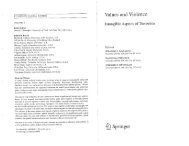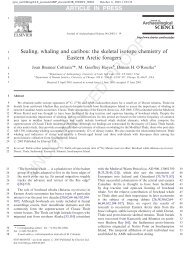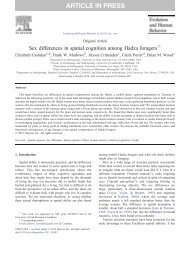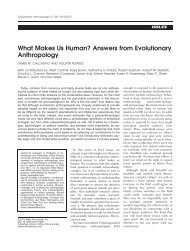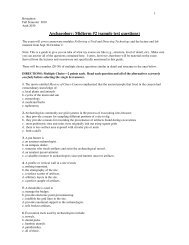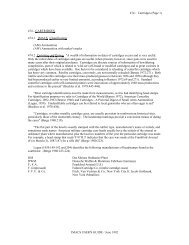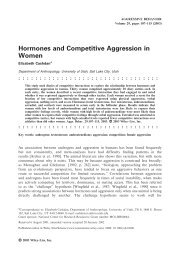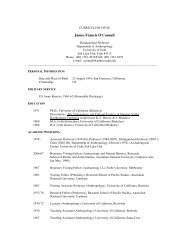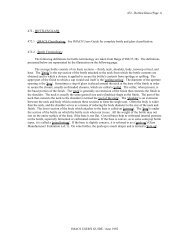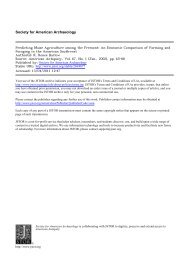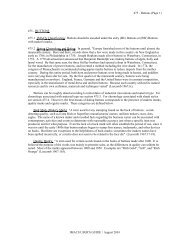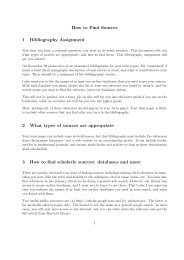476 - Shoes (Page 1) IMACS USER'S GUIDE / August 2001 476 ...
476 - Shoes (Page 1) IMACS USER'S GUIDE / August 2001 476 ...
476 - Shoes (Page 1) IMACS USER'S GUIDE / August 2001 476 ...
You also want an ePaper? Increase the reach of your titles
YUMPU automatically turns print PDFs into web optimized ePapers that Google loves.
<strong>IMACS</strong> <strong>USER'S</strong> <strong>GUIDE</strong> / <strong>August</strong> <strong>2001</strong><br />
<strong>476</strong> - <strong>Shoes</strong> (<strong>Page</strong> 2)<br />
There are two basic types of shoes: turned shoes and shoes whose upper is attached to the insole and<br />
reinforced by the outsole and heel. The upper of a turned shoe is sewn inside out to a single, thin sole.<br />
Then it is turned right side out. Today turned shoe manufacture has generally been replaced by the<br />
cementing process, but archaeologically this form abounds and can be easily recognized. The single sole<br />
has a thin, feathered strip of leather on the inside of the sole. The upper is stitched to this strip when inside<br />
out.<br />
Any mass-produced shoe can be further placed into one of three groups based on the method of<br />
attaching the outsole to the upper. A shoe is nailed (or pegged or screwed), sewn, or cemented. Even<br />
fragmentary pieces of sole leather generally betray the method of manufacture. Nails may still be intact, or<br />
their corroded remains visible in a nailed shoe. If the nails are gone, the round hole remains. There are no<br />
channels, feathered ridges or ribs. Thread from a stitched shoe will probably be gone, but small needle<br />
holes will remain. These are generally much smaller than those left in nailed shoes and are slightly oval.<br />
There may be indentations in the leather between the holes, indicating tightly pulled thread. Sewn shoes<br />
will have an outsole channel where the stitching occurs to keep the thread from being worn. They may also<br />
have a feathered edge on the bottom of the outsole with the stitching underneath. Feathering was a method<br />
used around the turn of the century for protecting stitches from wear. Often this feathering is worn off at<br />
the ball of the outsole, but will still be present on the shank. A McKay shoe will have stitching on the<br />
inside of the insole. If the stitching does not include the toe and heel, it may be dated before McKay's 1862<br />
patent. Goodyear Welt shoes are recognized by the unique rib on the underside of the insole. Cemented<br />
shoes occur late and are distinguished by the fact that the part of the upper cemented to the insole will be<br />
intact. This glued piece may be the only remaining fragment of a cement shoe's upper.<br />
A study of fashions and stylistic changes provides another source of chronological information.<br />
However, consideration of styles is outside the scope of this paper. Reports on shoes should utilize the<br />
terminology for shoe parts and manufacturing processes that are standard within the shoe industry. Primary<br />
sources, including shoe manufacturers' guides, trade catalogues, and patent records should always be<br />
consulted. Archaeological and other reports have relied on secondary sources containing factual errors which<br />
are perpetuated in the literature.<br />
Footwear can be dated by technology alone. Archaeologists working in post-1850 sites need to be<br />
aware of the information that can be derived from old shoes.<br />
"Innovations in the shoe making industry have been cited by Anderson (1968) and include some easily<br />
identifiable and datable changes. Foremost in importances, we have discovered, were the developments of<br />
the 'Goodyear Welt' technique of shoe manufacture in 1875 and the all rubber heel, an innovation of 1895"<br />
(Buckles et al. 1978a:445, 448).



